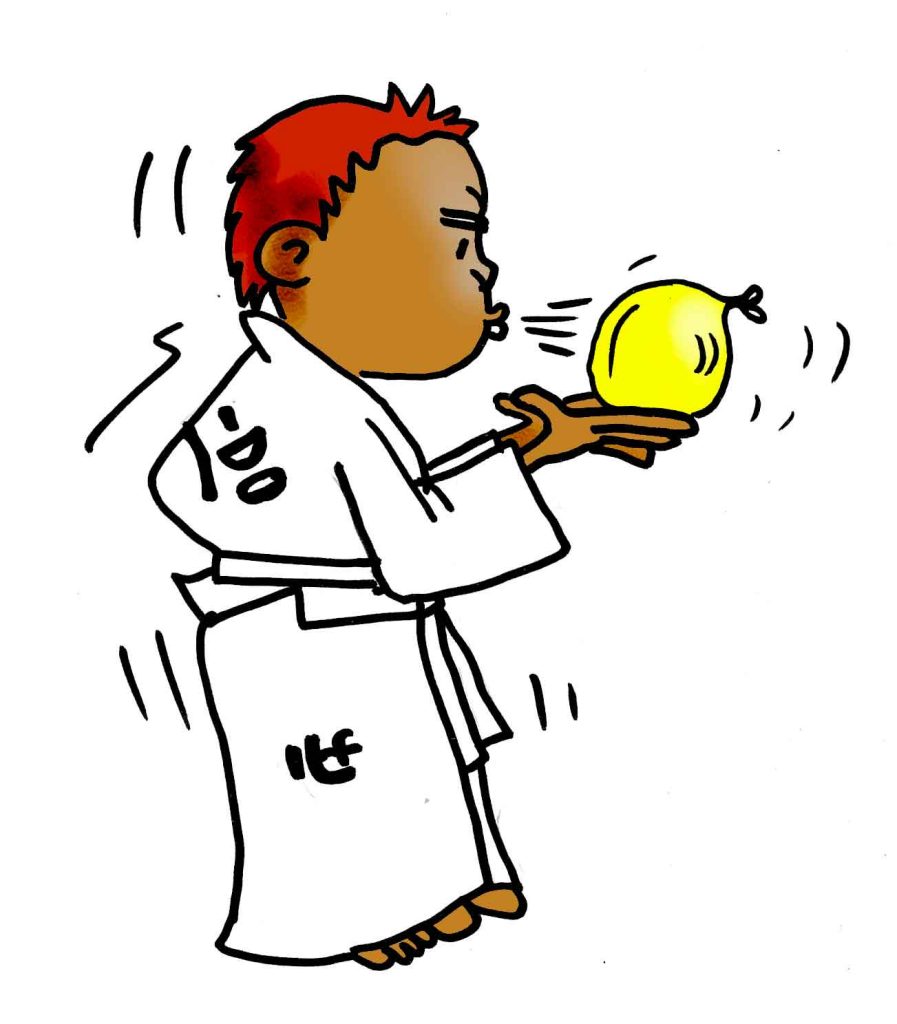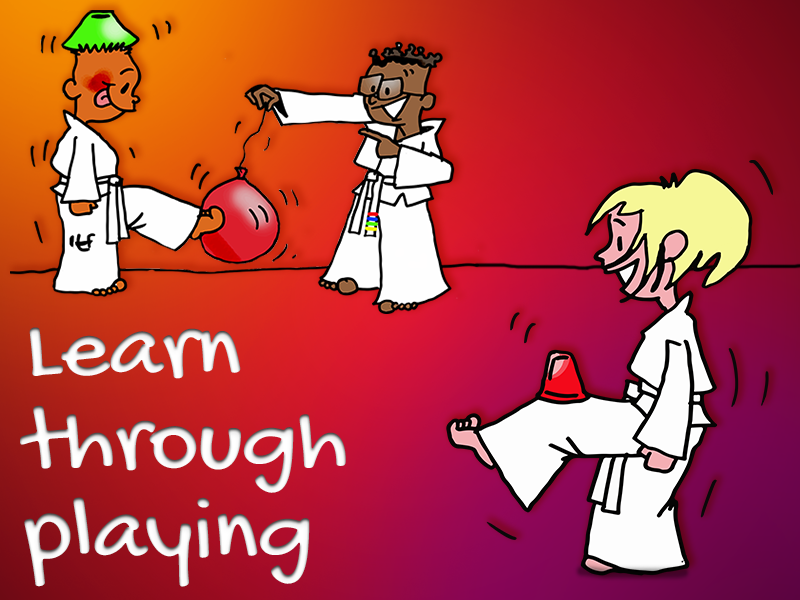By: Sahyun Nim Fabián Izquierdo
Member of the Children’s Development Committee
Many times, when talking about playing, about using games in a TKD class, the question arises, the doubt about if it is right or wrong, whether it is serious, or it seems that we are talking about, or worst, we are teaching children, to take with little seriousness our art.
But the truth is that is better to begin to unravel the matter and nothing better to start by making some clarifications.
First, we must know what the term “Playing” implies”.
I speak of what it implies and not of its theoretical definition, regardless of whether playing is considered as educational per se or as an educational tool I consider that the important thing is to know the characteristics that define it.
Several authors consider that the game is an activity:
- Free; since it should not assume any obligation and can be abandoned at any time. However, playing for learning supposes the existence of rules, but within those rules, they all have to feel free to create options so it doesn’t result boring and discarded.
- Delimited; circumscribed to a limit of time and space;
- Subjected to their own laws; paying demands an order and any deviation or transgression to that rule spoils the game. Rules can be established or improvised.
- Uncertain; its development and result cannot be given beforehand;
- Fictitious.
- It has an end in itself.
- It represents a challenge; if it is wanted to achieve something will be necessary to strive and that will serve as a motivation.
- Fun; although it suppose an effort for the body and mind, thanks to the emotions it generates, the participants can retain what they have learned.
While also may be found some other features in the extensive existing literature, I think we already have a clear idea of the kind of activity they are referring to.
But apart from those, there is a big coincidence that playing help the children to cope with traumatic or difficult situations. According to numerous psychoanalysts, by playing, the child repeats pleasant situations and also elaborates the bad ones.
Through play, the child expels and dominates his fears, anxieties and concerns as it acts as an escape valve.
In the case of young children, playing is their world, their language, their life.
Some go further and claim that every healthy child wants to play.
Many professionals also argue that playing is not a complementary activity in education. There is no difference between playing and learning because any game that presents new demands to the child should be considered as an opportunity to learn.
Attention, memory and wit, according to specialists, are intensified the paying and all these learning will be transferred to non-recreational situations.
Playing introduces the child into the world of ideas.
However, playing does not supplant other forms of teaching.
As we can appreciate, playing is a serious activity for children.
It would therefore result a real waste to lose such a resource when talking about learning, including the learning of Taekwon-Do.
Playing and its difficulties

According to physical education professor Alejandro Orbelli, an expert in playing for developing motor skills and neuroscience applied to sports, “playing has no ages, but has difficulties”.
Obviously that the age serves as an element of reference, but what this professional refers to, is that in no way the date of birth must sentenced whether a child, adolescent or adult can or cannot play. The acquired skills are what will allow enjoying the recreational process and learn through it, or not.
It is a fact, continuing with that reasoning, that a same game can be used by children, adolescents, adults and older adults, only by making adjustments or adaptations to their rules. What they should never miss are some of the characteristics that we mentioned before.
For the reasons expressed above, is fundamental when is time to plan the children class, to know in which stage of psychophysical development each student is.
An instructor must know that in a class it is possible to teach everything to everyone, but this implies that it is not possible to expect the same result from everybody.
It is clear, then, that when talking about playing in a children’s class we do not refer to “free time”, but to the use of an indispensable tool for the natural development of life skills, social skills, of coordination, of the mind and of those indispensable in TKD.
On the other hand, many sociologists and analysts agree that we live in a society that sells “challenges without effort” and that is immersed in a dynamic of “fierce competition” of one against another.
Faced with this situation, our answer is to sustain that the boys and girls should have a good time. They must have fun.
And due to the fun that the child experiences during the dynamics of the playing, a “positive emotional excitement” is generated which facilitates the learning.
But all the boys and girls in the class should have fun, not just a few.
And a TKD class should not be the exception, for that reason, every time I dictate a Workshop or a Course of the Children Development Program from the ITF TKD, I allow myself to share the reflection of Sahyun Nim Gato Gato, from Puerto Rico: “Life is full of serious moments that we can adorn with humor. What children learn by smiling, they remember with a smile”.
Proposal
After so much theoretical explanation, it just remains to emphasize that the use of games in a class of infantile TKD is not only a possibility, but should be the rule.
To do this, I propose to perform the following exercise.
Take a general class plan and replace all those activities that are considered “serious” regarding to the learning, for others that involve “playing”.
A good resource is to elaborate a table like the following:
- Educational objective. Answer the question: what do I want to teach? Or, what is the same: what do I want them to learn? And I explain which the accomplishments we pursue are.
- Activity. Answer the question: How could I get them to learn? Doing what? And I explain the mechanics.
- Requirements, necessary materials and accessories. Answer the question: with what do I teach? Or, what do I need to do the activity? Also in this column, we can include the answer to: where do I teach? That mean, the characteristics of the necessary place.
- Ages. Let recall that more than the date of birth, we refer to the skills achieved.
- Regulation.
- Time.

After performing each activity, it is convenient to take note of the results obtained; this will allow us to make adjustments for the planning of future classes in order to optimize the teaching – learning process.
Let’s get started.
Sources consulted:
- Curso de Juegos Motores in charge of Professor of Fhysical Education and expert in Neuroscience applied to sports, Alejandro Orbelli. Argentina.
- Jugar y divertirse sin excluir. Rosa Guitart Aced. Editorial GRAÓ, de Serveis Pedagógics. Barcelona. 1st edition.
- Educar Jugando. Mavilo Calero Pérez. Editorial San Marcos, Lima, Perú. 1998.
- Educar en valores y aprender jugando. Aurora Muñoz Sandoval. Editorial MAD SL. Alcalá de Guadaira, Sevilla, España. 1st edition.
- Jugar, aprender y enseñar. Noemí Aizencang. Ediciones Manantial SRL, Buenos Aires, Argentina. 2005.
- Gamificación en el aula. Neuromotricidad en el aprendizaje de las matemáticas y el lenguaje. Grupo de investigación Ne. S.A. Editorial Amazon. Pablo Del Pozo Moreno. 2019.


 ITF Statement in support of the Ukrainian ITF members, its practitioners, and all the people of Ukraine
ITF Statement in support of the Ukrainian ITF members, its practitioners, and all the people of Ukraine















Excelente información,
Tendrán más contenido de Taekwon-Do Kids? Podrían enviármelo a mi correo para seguir capacitandome.
Se los agradezco mucho.
Saludos